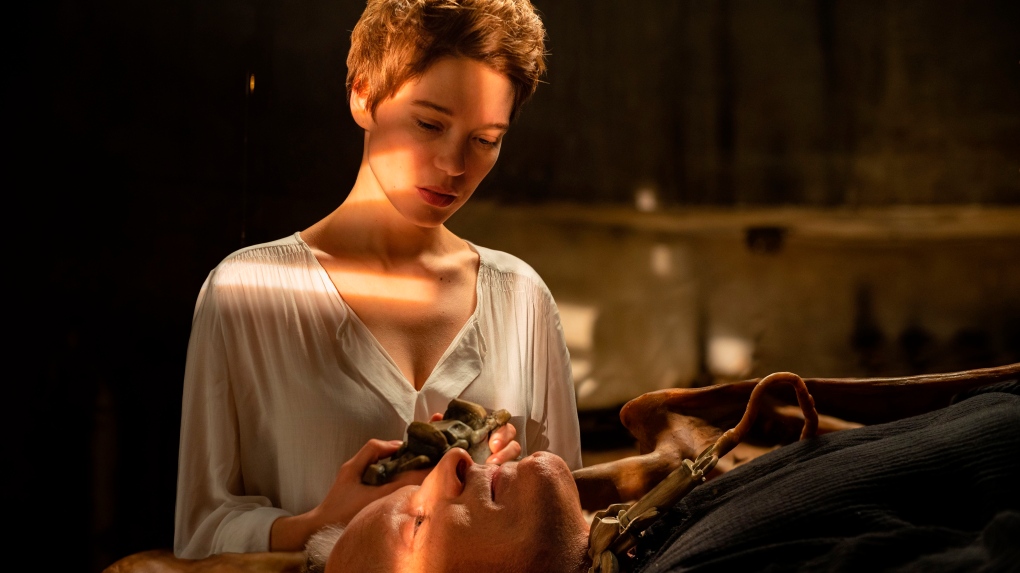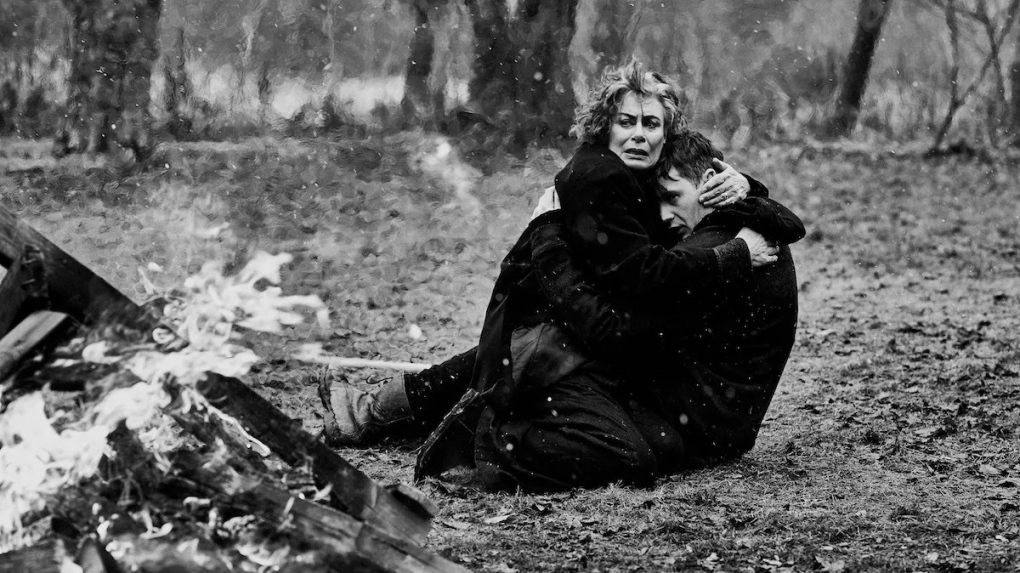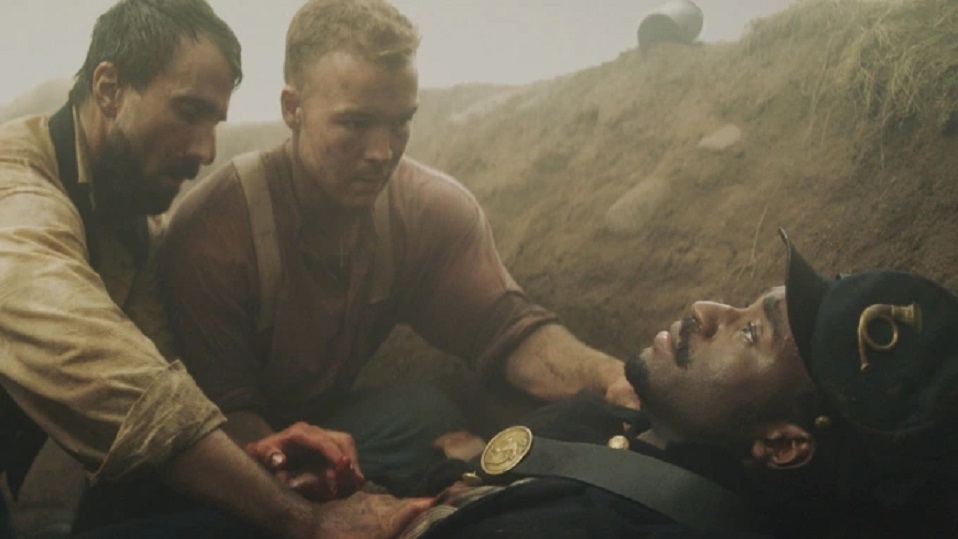CRIMES OF THE FUTURE: 3 ½ STARS
 This image released by Neon shows Lea Seydoux, background, and Viggo Mortesen in a scene from "Crimes of the Future." (Neon via AP)
This image released by Neon shows Lea Seydoux, background, and Viggo Mortesen in a scene from "Crimes of the Future." (Neon via AP)
They say imitation is the sincerest form of flattery. If so, David Cronenberg must be basking in the reflected glow of some pretty serious film fawning. The OG of Body Horror’s influence can be seen in lurid detail in recent movies like the Palme d'Or winner “Titane” and Natalie Portman’s biological thriller “Annihilation” among others.
The Virtuoso of the Grosso Rosso returns to cinemas after an eight-year break with “Crimes of the Future,” an all-star story of eroticized human evolution starring Kristen Stewart, Viggo Mortensen and Léa Seydoux.
Named after an early Cronenberg movie and based on a script the director wrote in the early 2000s, “Crimes of the Future” takes place in a time when "Accelerated Evolution Syndrome" has all but eliminated pain in most humans.
“Desk top surgery” is commonplace and a practice that performance artist Saul Tenser (Mortensen) and former trauma surgeon Caprice (Seydoux) turn into a form of nightclub bio-entertainment.
Saul’s advanced AES enables him to grow new, never-before-seen organs, which Caprice removes as part of their medical-theatrical shows. The gruesome act attracts lots of attention, particularly from Timlin (Kristen Stewart), an investigator from the National Organ Registry who becomes enchanted by Saul. “Surgery is the new sex,” she coos to him. “I wanted you to be cutting onto me.”
There’s more. Transformation activist Lang Dotrice (Scott Speedman) requests Saul and Caprice perform a public autopsy on his late, eight-year-old son. The New Vice Unit (“There’s no crime like the present!”) investigates the rapidly changing world of body modification while Saul considers entering a literal “inner beauty contest.”
Despite the array of bits and pieces we see on screen, the most important body part in “Crimes of the Future” is the head -- Cronenberg’s head. The director has made a cerebral film, one that riffs on his “Videodrome” era “old flesh versus the new flesh” mantra.
Laden with metaphor, it’s a portrait of a rapidly changing world where bodies are morphing and shadowy government organizations work feverishly to understand the repercussions. They fear too much evolution could lead to insurrection. That eventually we’ll morph into something that isn’t strictly human, and wonder what happens when we can’t feel anything anymore.
That last point is the film’s beating heart. When Saul tells Timlin that he’s, “not very good at the old sex,” it signals a search for something new, of different sensations. In a numb world, where do you go for kicks? Is it the performance art of Saul and Caprice, or something else? Is it evolution or revolution, or both? If everything is changing, is anything new?
“Crimes of the Future” asks many questions, but stops just short of providing understandable resolutions. Cronenberg is interested in provocation, in world building, in bringing together previously investigated themes (cults, new flesh, odd children) in a new way to add brush strokes to a painting he began with films such as “Shivers” and “Rabid.”
Cronenberg’s “A History of Violence” and “Eastern Promises” muse, Mortensen, gets under the skin of Saul. Charismatic, he’s a rock star of a sort, willing to give of himself for his art. Often hidden under an Ingmar Bergman “Seventh Seal” cloak, he is a reluctant celebrity, a man who spends the bulk of the film reacting to his surroundings, his body and mutations. It’s something different for Mortensen. Saul is a passive, brooding character vulnerable to the whims of his ever-changing body. It’s a quiet yet powerful performance that details a man trying to maintain his humanity, despite the elimination of many of his most human traits, pain being chief among them.
Co-star Seydoux’s mix of sensuality, artistry and humanity brings warmth to the film’s cool texture.
Stewart, as the mousy Timlin, is all eagerness. She’s timid but curious, speaking in a strange cadence, as if a hummingbird dubbed her lines.
Both help blunt the edge of the blood-splattered story, bringing feelings to a world drained of such sentiments.
“Crimes of the Future” is an olio of ideas. The neo-noir setting plays host to an unconventional love story, a parable of climate change (characters have a taste for waste in a world where garbage is becoming more accessible than food), evolution, and the search to feel something real. The result is a subversive movie that, as Caprice says, is “juicy with meaning,” but perhaps too enigmatic for those unfamiliar with the director’s body horror oeuvre.
THE RIGHTEOUS: 3 ½ STARS
 A scene from 'The Righteous.' (Arrow Films)
A scene from 'The Righteous.' (Arrow Films)
“The Righteous,” a new supernatural thriller written, directed and starring “City on a Hill’s” Mark O’Brien, is an unsettling, slow burn on redemption and retribution that asks, “What is the price of sin?”
“Be careful what you wish for. But be certain what you pray for.”
Shot in lush, black and white, and set in a remote home far from the closest neighbour, the quiet of the surroundings echoes the somber lives led by Frederic (Henry Czerny) and Ethel (Mimi Kuzyk) Mason, a married couple still stinging from the loss of their daughter.
Frederic is a pious man, a former priest who left the church in scandal after falling for Ethel. Their carefully calibrated lives are turned upside down when Aaron Smith (O'Brien), an injured man with good manners and a secret, shows up at their door. Lost, he needs help, aid Frederic is happy to oblige. “Where are you from?” “Everywhere,” he replies.
At first, he is a welcome guest. Ethel warms to him, finding comfort in the presence of a young person to fill the hole in her heart. But late-night dinner table conversations between Frederic and Aaron change the nature of their relationship, leading to a combustible situation and a horrifying request.
“The Righteous” is a psychological thriller that takes its time, doling out the story’s inherent sense of menace slowly, but surely. As the tension mounts, director O’Brien resists the temptation to up the action. Instead, he trusts the script and performances to bring the strange, powerful story of atonement to its conclusion.
The horror of the situation escalates courtesy of the battle of wills between Aaron and Frederic. It’s the struggle between good and evil, of faith and the secular life, propelled by a series of kitchen table conversations between Aaron and Frederic that are the jaundiced soul of this story. Beautifully performed, they are chamber pieces, enhanced by subtle yet effective shifts in lighting that telegraph the changing mood, and spiritual angst, of the scenes.
A small film containing big ideas, “The Righteous” succeeds because of a clarity of direction—O’Brien knows what he wants to do in every scene—and the performances, from Czerny’s tortured gravitas and Kuzyk’s warmth, to O’Brien’s enigmatic work.
FOXHOLE: 3 STARS
 A scene from 'Foxhole.' (GLASS EYE PIX)
A scene from 'Foxhole.' (GLASS EYE PIX)
“Foxhole,” a new anti-war film now on VOD, links five soldiers over the course of three conflicts -- the American Civil War, the First World War and the Iraq War -- as they make the kind of life and death decisions that could have far reaching repercussions.
Director Jack Fessenden makes the most of a small budget to bring his film’s inter-generational gimmick to life.
Divided into three vignettes, all ripe with confusion and camaraderie, each segment is shot in a cinematic style that reflects the era in which it is set. From the sepia tone look of the Civil War section and the black and white, formalist, propaganda film feel of the First World War segment, to the more frenetic Iraq War sequence, each is distinguished stylistically.
What connects the multi-generational stories are the actors, who play different characters each time out, and the moral dilemmas faced by them. These sequences are claustrophobic, fraught with danger, volatility and a sense of uncertainty. As these elements swirl, the marooned soldiers are confronted with ethical decisions.
During the Civil War, four Union soldiers must decide whether to transport a badly injured Black soldier (Motell Gyn Foster) to the hospital for treatment. The question of the dead or alive value of a German captive is the centre point of the Great War vignette, while the Iraq War section shows the horror of an ambush.
The actors, Foster, Cody Kostro, Angus O'Brien, Alex Hurt, Alex Breaux, Asa Spurlock and James Le Gros, ably portray the range of honour, sacrifice and camaraderie inherent to the character of a soldier and valiantly work through the script’s wall of dialogue. Still, as wordy and occasionally pedantic as Fessenden’s script is, the ideas buried within are worthy of thought.
The visuals though are stronger. The film is bookended by twin shots that showcase both the futility and inevitability of war. These two shots, set 100 years apart, sum up the film’s anti-war sentiment in stronger “language” than any of the dialogue.
“Foxhole” is an uneven, although audacious and ambitious film, that fares better as provocative purveyor of ideas than a cohesive whole.

Post a Comment